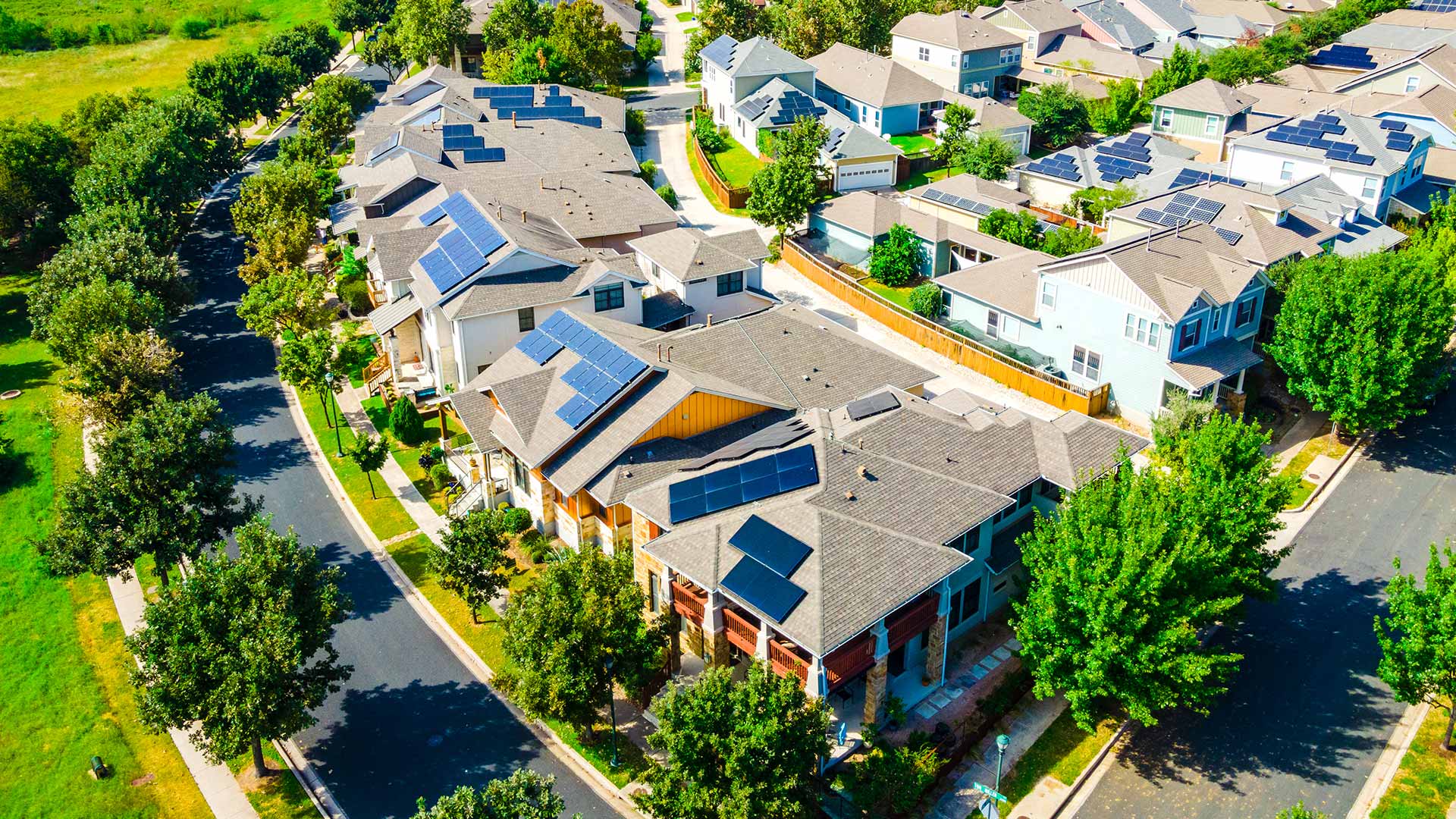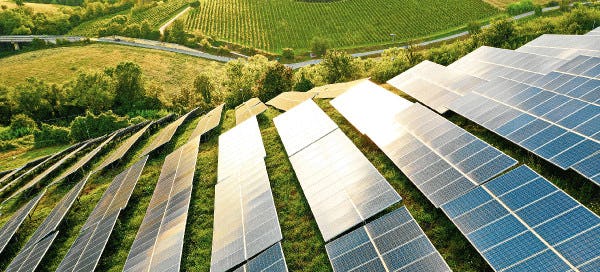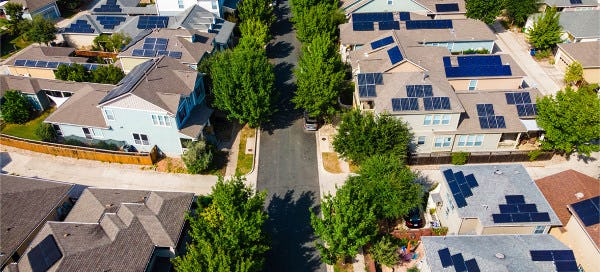Rooftop solar is a photovoltaic (PV) system of solar panels that generate electricity on the roof of your home or business. While these are small compared to the massive solar farms you might have seen around our great state, they are highly effective at capturing sunlight and converting it to green energy.
The sun is a never-ending source of energy. Given its availability, renewability, and many benefits, the sun's energy is among the best alternatives to fossil fuels.
Get a Solar Quote from Rhythm Energy in Minutes
At Rhythm Energy, we have a free and unbiased concierge service to help you determine if solar is right for your home. We could help you save thousands by making sure you have the perfect solar and battery storage system, solar panel installers, and quote.
How Do Residential Rooftop Solar Systems Work?
Rooftop solar panels rely on how much energy a solar cell (small square-shaped silicon device) can hold to capture the sun’s light and convert it to power. Photovoltaic cells, mounting systems, cables, solar inverters, and other electrical accessories are all among the different components of a solar panel system.
Photovoltaic cells, like those found in solar calculators, make up most rooftop solar panels. Housed in plastic or glass to protect them from the elements, they are made up of layers of semiconductor materials composed of doped silicon crystals. The bottom layer contains boron, which bonds with the silicon to form a positive charge. To create an opposite and negative charge, the top layer is covered with phosphorus.
The point where the two layers come together forms a positive-negative junction; because the layers have opposite charges, this surface moves, generating direct current electricity.
Inverters are included with rooftop solar panels to convert the direct current electricity into alternating current (AC), which most electronics and home appliances use.
Types of Photovoltaic Cells for Rooftop Solar
There are three basic types of solar cells used in rooftop solar panels.
Single-Crystal Cells
Long cylinders make up these solar cells, sectioned into hexagonal or circular wafers. Because they are high-efficiency cells, they are more expensive than other photovoltaic cell types. Installing them can improve your home's energy efficiency by up to 30%. Single-crystal cells make up about 29% of the global market.
Polycrystalline Cells
These cells are created from molten silicon shaped into bars and then cut into smaller squares. They cost less money to fabricate polycrystalline solar cells, but they also have 15% lower efficiency than single-crystal cells. Because the squares are tiny, they are packed closer together to increase energy production.
Amorphous Silicon
The least expensive of the three cell types are the amorphous silicon cells. These cells are silicon sprayed onto a glass or metal surface in thin layers. They have a lower energy conversion efficiency of only 5%.

Rooftop Solar Investment: Is It Worth It?
What Are the Economic Benefits of Using Rooftop Solar Power?
Rooftop solar power is a cost-effective solution for your home. Although solar panels come with a significant upfront investment. However, over time, they can be more affordable than diesel generators or power grid electricity, because once the solar power takes the place of on-grid electricity, your energy bills will go down.
Lower Utility Costs: The cost of electricity from solar systems is typically lower than that from traditional utilities. Solar systems also provide the opportunity for you to sell any excess energy that you generate but don’t use back to the grid.
Lower Costs During Outages: When the grid experiences an outage, a solar system with battery storage can provide stable electricity, saving money on the cost of running a fuel-powered generator.
What Are the Environmental Benefits of Using Rooftop Solar Power?
Rooftop solar panels create electricity using only the sun’s light, making them a cleaner energy source than most other options. Rooftop solar does not pose any health risks or release harmful pollutants, and there’s no need for homeowners to be concerned with purchasing additional land for the installation of the system. And because the sun is a renewable energy source with zero emissions, solar panels can assist in reducing climate change.
Will Adding Rooftop Solar Panels Increase My Home’s Value?
Solar panels are considered to be home upgrades, much like a renovated bathroom or a finished attic, often adding around $15,000 to the price for a home with an average-sized solar array. Having solar panels may even help your home sell more quickly, because of the added attractiveness to home buyers.
How Much Does It Cost to Install Rooftop Solar Panels?
The average upfront cost of a home solar power system is between $10,000 and $18,000. This price will depend on the location of your home, the size of the system, and other factors. There are also long-term costs: although most solar panel systems are designed to last for more than 20 years without needing significant updates, they do require occasional cleaning and maintenance.
Paying Cash Upfront for Rooftop Solar
The least expensive way to install solar panels is to pay cash upfront, because you won’t be paying interest. This also allows you to own your solar system outright.
Home Equity Loans for Rooftop Solar
A bank or credit union may loan you money to self-finance your purchase. Just make sure that you have sufficient equity in your home, as well as good credit in order to get the most out of the arrangement.
Leases for Rooftop Solar
In some cases, you can enter into an agreement with a third party, where they design, permit, finance, and install a solar system on your home. In this case you will not own the system but will buy electricity from the developer, often at a lower rate than buying electricity from local power companies.
Costs of Maintaining Rooftop Solar Panels
Solar panels are low maintenance, durable, and have no parts that will break. Whatever minor damage might happen due to weather should be covered by the warranty. But there are some fees associated with the lifespan of your solar panels, including the following:
Inverter replacement: approximately every 10 years
Panel inspection by your contractor: once a year
Increased insurance premiums due to additional coverage for your solar power system.
The panels will need to be cleaned regularly, but you can do this yourself or hire a contractor to do it for you.
Are There Any Incentives or Rebates Available for Rooftop Solar Installations?
Homeowners can usually claim a 30% tax credit on their income taxes for the cost of installing a solar system. The Department of Energy has created a Homeowner's Guide to the Federal Tax Credit for Solar Photovoltaics, giving an overview of the federal investment tax credit for those interested in home solar systems.
How Long Do Rooftop Solar Panels Last?
These systems are designed to last for 20-30 years without significant upgrades, although you will need to clean and maintain them on a regular schedule.
Residential Rooftop Solar Panel Requirements
Most roofs are equipped to handle the installation of solar panels. However, several factors will determine the cost, size, and efficiency of your solar energy system.
Direction: North-facing roofs often lack direct sunlight, making them a less desirable choice for solar panels
Shade: Your panels should be exposed to a minimum of 5 hours of sunlight each day. If large trees or buildings keep the sun from shining on your roof, they could prevent solar panels from working effectively. Weather conditions such as air temperature and snow do not have an effect on rooftop solar panels
Angle of the Roof: The ideal angle for installing solar panels is 30 degrees. However, anywhere from 0 to 45 degrees is acceptable. If you have a flat roof, tilted racks are used for mounting your solar panels
Size: Residential solar installation requires a minimum of 500 square feet of adjacent space
Type of Roof: Rooftop solar systems are most successfully mounted on asphalt shingles or corrugated metal roofs. Slate or tile can be used, but the installation is more complex and expensive. Wood shingles are the least desirable option because they could present a fire hazard
Age: If you know your roof needs to be replaced soon, consider doing it before having your solar panels installed. It will cost you more money to remove and reinstall your solar energy system so your roof can be replaced.
Is Your Roof Right for Solar Panels?
We’ve put together a quick list of factors to consider, when it comes to making sure your roof is suited for solar panels:
Factor | Importance |
Roof orientation | Determines sun exposure and energy production efficiency. |
Roof angle | Affects the amount of sunlight hitting the panels. |
Amount of shade | Impacts energy production; less shade is better. |
Roof size | Determines how many panels can be installed. |
Roof material | Influences installation feasibility and cost. |
Roof age and condition | Ensures the roof can support solar panels long-term. |
Local climate | Affects solar panel efficiency and durability. |
Structural integrity | Determines if the roof can support the weight of panels. |
Solar access rights | Legal rights to install and maintain solar panels. |
Local building codes and regulations | Compliance with local laws for solar panel installation. |
Rooftop Solar Buyback Plans in Texas
Your solar energy system may create more renewable energy than you use during peak sunlight hours. If so, you can either store additional energy in a solar battery or use a buyback program to sell excess energy back to your retail electricity provider.
Storing the remaining energy in a solar battery can help you stay connected during power outages or power areas of your home at night.
Rhythm Energy’s solar buyback plan to pay yourself for unused energy! Buyback credits will appear on your monthly statement, so you can watch your overall energy costs go down. Signing up is simple. The team at Rhythm Energy is always available, so contact us anytime if you have questions about rooftop solar and its many benefits for your energy bill and the environment.
Think Rooftop Solar Might Be on Your Home's Horizon?
Our free solar concierge service is staffed with knowledgeable, friendly experts who are here to help. Don’t hesitate to reach out to us with any questions!
FAQs
Do rooftop solar panels work at night?
Solar panels don’t work at night because they require the sun’s light to generate energy. But during the day, excess electricity generated by your system can be stored in a battery. The electricity stored in your battery can subsequently be used to power electrical equipment at night.
Is rooftop solar a suitable energy source during inclement weather or cloudy days?
Solar panels can be used at any time of the year, even in the winter. Not even snow can shut down your solar power. As the snow melts, it simply slides off the panels if they are set at a tilt. Even when it’s cloudy, your panels will generate electricity; however, the output will be significantly decreased. Because there is a close link between solar production and sunlight hours, panels produce less electricity in the winter.
What happens to extra energy generated by rooftop solar systems?
It can be stored in a solar battery or even sold back to the grid through a solar buyback plan.




